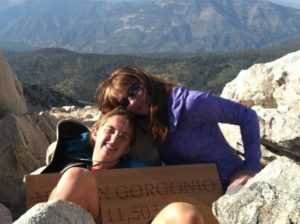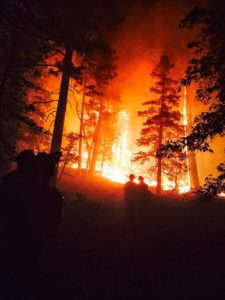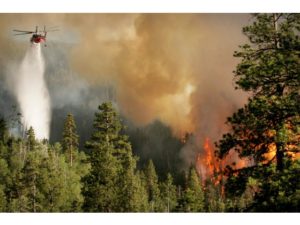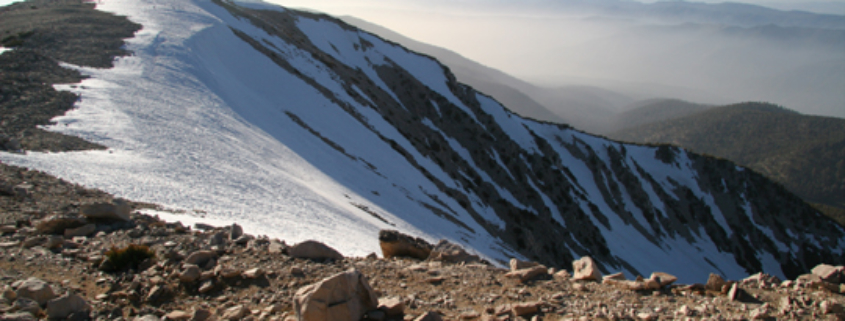Moths to a Flame
In July 2012, my teenaged daughter Reiley and I hiked into the San Gorgonio Wilderness—a landscape of rolling foothills, canyons, and steep slopes that marks the eastern boundary of the Los Angeles Basin. Our destination was Mt. San Gorgonio. The 11,503-foot peak, fondly called “Old Greyback,” is the highest mountain between the Sierra Nevada mountain range and the Mexican border.

Ridgeline to San Gorgonio Peak (http://scoutfitters.org/trip/san-gorgonio-ultralight-summit/)
The steep Vivian Creek Trail to the peak begins with an easy “warm up” hike through Mill Creek Canyon before climbing 1,000 feet and over a mile of switchbacks to reach the forest surrounding Vivian Creek. The dark, luxuriant woodland is more than beautiful enough to sustain hikers to the 10,000-foot point where a long ridgeline traverse to the summit begins. The remaining hike consists of a steady climb across a field of rock and boulders well above the tree line, and completely exposed to the sun. The view of nearby Mt. San Jacinto and the Inland Valley below is stunning. Still the long haul across that blinding gray-white moonscape is grueling, even absent the sensation of skin burning, or the headache and nausea that accompanies altitude sickness.

Reiley and me at the top.
Reiley and I were training for our summit of Mt. Whitney—elevation 14,505 feet—later that summer. Summiting a “fourteener,” in reference to peaks over 14,000 feet in elevation, is a rite of passage for teens in our family. Meeting this challenge is empowering, and provides perspective on the many trials a young person faces as she makes her way through high school and college, enters the workforce and establishes her career, and builds a family of her own. Break up, layoff, health crisis? I can already hear Reiley saying, “Pshaw. I climbed a mountain, in a snowstorm, with my food, clothing, and home on my back.”
Three years after that trek with Reiley, a devastating wildfire forced my son Parker and me to abandon our plan to hike Mt. San Gorgonio in preparation for his fourteener. Old Greyback marks the horizon northeast of my home in western Riverside County. During the early days of the summer 2015 Lake Fire, smoke billowed and then dissipated into a band of yellow-gray haze that hid the peak from view. The fire ultimately consumed more than 30,000 acres of the San Gorgonio Wilderness, and all trails in the area remained closed for weeks after the fire was contained.

Lake Fire consumes forests in San Gorgonio Wilderness
My disappointment about forgoing our trip was compounded by despair over the loss of favorite species and beloved locales that I shared with hikers, scientists, and those who live nearby the Wilderness, which is known for its abundant waterways, lakes, lush green meadows, pine and cedar forests, aspen groves, wildflowers and wildlife, and hundreds of miles of trails. “My heart is breaking,” Kandy posted to the San Gorgonio Wilderness Association’s Backcountry forum, along with a map marking the fire’s spread over the South Fork (of the Santa Ana River) drainage, revered for its alpine meadows, old growth pine forests, a treasured grove of quaking aspen, and awe-inspiring views of the San Bernardino’s granite peaks. Zippetydude posted in response, “I just can’t imagine life without the South Fork/Aspen Grove area.”
We naturally become attached to particular places, and are saddened when they are harmed or destroyed. According to biologist E.O. Wilson’s biophilia hypothesis, “human beings subconsciously seek connection with the rest of life.” Social geographers Joyce Davidson and Christine Milligan explain that the way we feel about a place “connects” our psychological and physical experiences to geographic locations” (524). “The…environment literally gets into the individual,” Teresa Brennan once said. The distress caused by environmental damage or loss due to natural disasters, industrial pollution, or institutional change is called “solastalgia,” a portmanteau of the words “solace” and “nostalgia.”
Nature and place-based writing can heal solastalgia by identifying, interpreting, and transforming environmental loss. This literature—from Henry David Thoreau’s Walden, to modern classics such as John Muir’s writings, Aldo Leopold’s “land ethic” in A Sand County Almanac, Rachel Carson’s groundbreaking Silent Spring, and Dr. Seuss’s The Lorax, and current best sellers, including David Georg Haskell’s The Forest Unseen, Helen Macdonald’s H is for Hawk, and Michael McCarthy’s The Moth Snowstorm—draws attention to the natural world, recognizes human connections to it, and frequently calls for its protection.

Start of Peoples Climate March
Bill McKibben’s The End of Nature is a critical case in point. Published in 1989, it is among the first books about global warming intended for a general audience. McKibben argues that our capacity to change “the wind, the sun, the rain” (41) destroyed the idea of nature as pristine and unaltered by human ways of life. He cries out, “What will I do without [it]?” And he admits self-loathing for his part in humanity’s failure to avert climate disaster (86). McKibben managed to survive this existential crisis, and went on to found the campus-based 350.org, protest the Keystone XL oil pipeline, and organize the September 2014 People’s Climate March that brought more than 400,000 demonstrators to the streets of New York City.

Moths swarming.
More recently, McCarthy’s argument in The Moth Snowstorm weaves together memoir, science and natural history, and environmental ethics to craft a powerful call to action reminiscent of McKibben’s early work. But McCarthy seeks to inspire more sustainable behavior by appealing to our inherent sense of joy and wonder about the natural world, rather than bemoaning an ecologically diminished future. He recalls a time, before industrial farming consumed so much natural habitat in northwestern England where he grew up, when swarms of moths appeared, magically, like snow on warm summer nights. The threat of wildfires, tropical storms, and rising seas haven’t inspired conservation, but the possibility of magic just might.
The Lake Fire occurred during the fourth year of California’s ongoing drought. Though California wildfire season is May-September, late spring storms and a heavy snowpack in the San Gorgonio Wilderness have historically persisted well into summer, protecting the area from annual wildfires. By summer 2015, an overabundance of dried out trees, shrubs, and grasses and the record low precipitation had generated an unusually abundant supply of fuel, even at elevations well above 6,000 feet, where wildfires have long been uncommon.

Lake Fire
Scientists attribute the region’s changing climate to the accumulation of carbon dioxide and other greenhouse gases in the atmosphere. Average annual temperatures in California and throughout the Western United States have increased nearly 2 degrees since the 1970s, causing the winter snowpack to melt up to four weeks earlier than was the case forty years ago, and forests to dry out sooner and remain dry longer than before. A thousand more wildfires occurred in California during 2014’s extended seven-month fire season than the state’s historical average.
More than twenty-five years after the publication of The End of Nature, we remain a long way from sustainable adaptation to a significantly warmer climate. Still, I’m hopeful. A majority of people in every nation polled now agree that climate change is serious problem, one that is very likely to diminish the natural environments that we call home. And many of us are writing about it.
References
Brennan, Teresa. 2004. The Transmission of Affect. Cornell University Press.
Davidson, Joyce and Christine Milligan. 2004.“Embodying Emotion Sensing Space: Introducing Emotional Geographies.” Social & Cultural Geography 5.4: 525-532.
Kellert, Stephen and E. O. Wilson. 1995. The Biophilia Hypothesis. Island Press.
McCarthy, Michael. 2015. The Moth Snowstorm: Nature and Joy. John Murray.
McKibben, Bill. The End of Nature. Random House.
Juliann Allison is a feminist scholar, environmentalist, homeschool advocate, yogini, runner, rockclimber, mate, and mother of four with a passion for the outdoors. She is Associate Professor of Gender and Sexuality Studies and Public Policy at UC Riverside, and an MFA student at Antioch University Los Angeles.






